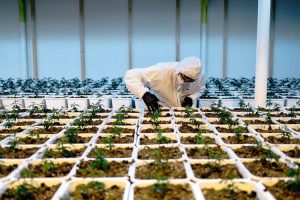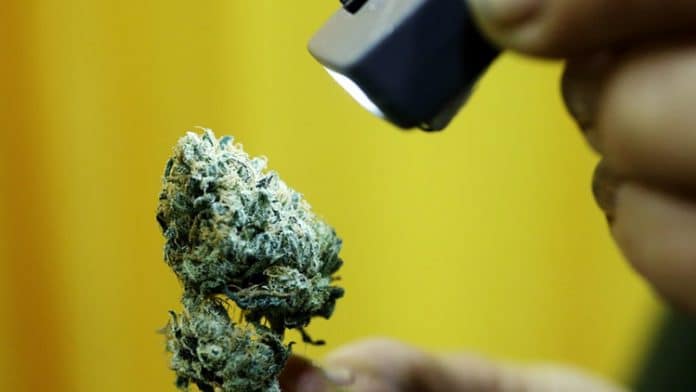Scientists are currently in the midst of exploring uncharted territory: The cannabis genome. Unlike with other plants, researchers don’t have a long history of closely analyzing the genetic makeup of the plant. But for the past seven years – as more and more states legalize medical and recreational pot – researchers have been working on producing a high-quality marijuana genome. Everyone from low-level researchers to larger companies are part of this effort, and they say mapping the cannabis genome could be highly beneficial to people who grow or use cannabis.
“No one has any idea what they’re smoking. Everything is name draw, so consumers and patients don’t know what they’re getting,” says Mowgli Holmes, co-founder and CEO of Phylos Bioscience, which has been working on its cannabis genome for over two years. “DNA sequencing uniquely identifies a plant, which allows growers to really tell their customers what plant they’re actually getting.”
Phylos Bioscience released its first reference genome for cannabis at the end of 2016. A team of Canadian researchers had released a cannabis genome in 2011, but, Holmes says, Phylos’ genome was far more complex and detailed. Though it’s been utilized by scientists around the world, Phylos is currently working to release an even more comprehensive genome.
In order to analyze a strain’s DNA, researchers put ground cannabis into a container and then add something called a lysis solution to release genomic DNA from the plant’s cells. From there, the researchers use several other solutions to separate out the different kinds of molecules in the cell so that DNA can be isolated for sequencing.
Phylos has a program where cannabis growers can send samples of their plants to the company to get the plant’s genetic information, which helps growers, and also helps the company add more genetic data to its genome. “We’ve now sequenced thousands of different plants, and we have by far the biggest database of individual plant data,” Holmes said.
Beyond just learning which plants most benefit growers and their customers, creating a comprehensive cannabis genome advances our understanding the medicinal properties of cannabis itself. Once scientists know how the DNA of the plant produces different compounds that can be used for medical purposes, says Holmes, they can breed medical marijuana for more specific purposes.
“The plants genetics control what chemicals they’re going to make,” Holmes says.
Though mapping cannabis’ genome is a large effort, the plant is relatively simple compared to the DNA sequence of other plants. Nolan Kane, an assistant professor of ecology and evolutionary biology at the University of Colorado, Boulder, who has worked on the cannabis genome, tells Rolling Stone that other genomes he’s worked are far more complicated.
“The genome itself doesn’t bring challenges that are insurmountable or unique, in the sense of the technical challenges,” Kane said. “It’s actually on the smaller side for a plant genome.”
Kane says the sunflower genome is “3.5 Gigabases” – a measure of the plant’s nucleotides, or its genetic building blocks – which is nearly five times the size of cannabis’ genome. He says plants like pine trees and spruce trees have genomes that are 40 times larger than that of cannabis.
Of course, with all this information there could be some drawbacks. Many worry that certain cannabis strains could be patented by large agricultural or pharmaceutical companies, which could do harm to smaller cannabis growers who fear the legal ramifications of butting heads with their larger counterparts. One of the leading companies that is researching the cannabis genome, Sunrise Genetics, is fully aware of people’s patenting concerns and shares some of those worries.
Some broad patents were given to those looking to protect strains they have developed, and Sunrise argues knowing more about cannabis DNA could actually help invalidate those broad patents.
“One major concern of our company, and in the field in general, is that some of the most recent patents granted for cannabis appear too far-reaching,” says C.J. Schwartz, CEO of Sunrise Genetics. “A recent example is a patent claiming unique combinations of cannabinoid and terpene profiles. How can you say something is unique when there is nothing to compare it against? What if you get those same profiles with a different strain (and a different combination of genes)?”
Sean O’Connor, a law professor who focuses on intellectual property at the University of Washington, says that cannabis patenting by large companies is definitely on the way. “If we get federal legalization… you’re definitely going to see both recreational and pharma folks coming in and trying to patent what they can, and then there is going to be competition and lawsuits,” he says.
O’Connor points out that pharmaceutical companies will be able to isolate strains of cannabis DNA and then create compounds found in cannabis in the lab, and that will result in them patenting many drugs based on their creations.

“Some of the most exciting but controversial research is in isolating and identifying cannabinoids and particular chemical compounds, not THC that gets you high but other things that could have therapeutic benefits, and then folks will… just generate that chemical,” O’Connor said. “They don’t need the whole cannabis plant. What you’ll see is a pharmaceuticalization of medical marijuana.”
With all of the patenting concerns in mind, Holmes of Phylos Bioscience is actually already working to fight off future cannabis patents. An archive of over 1,000 strains he helped create called the Open Cannabis Project is documenting the different strains Holmes and others have sequenced. Since there is evidence these particular strains already exist, it could help prevent those strains from being patented. If someone tries to patent a strain that can be easily found in the database, the patent office would likely not grant the patent, because there would be evidence it’s not new.
“We can’t stop the way patenting works in the world,” Holmes says. “All we can do is make data public and make it hard for people to patent stuff they shouldn’t patent.”














